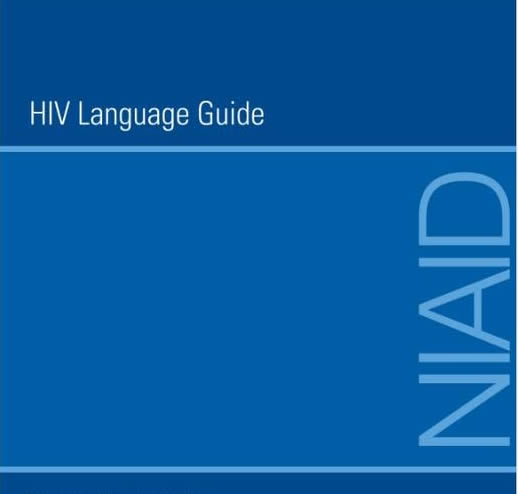
|
January 2025
HIV Language Guide (2024)
By National Institute of Allergy and Infectious Diseases

Background
This update of the HIV Language Guide was led by the Workforce Operations, Communications, and Reporting Branch (WOCRB) in the Division of AIDS (DAIDS) in the National Institute of Allergy and Infectious Diseases (NIAID), part of the National Institutes of Health (NIH).
The first iteration of the NIAID HIV Language Guide (hereafter referred to as “Language Guide”) was created in February 2020 by the NIAID Office of Communications & Government Relations (OCGR) News & Science Writing Branch (NSWB) with input from DAIDS WOCRB. Input and review were solicited from representatives of NIH, other public health organizations, and community-based groups to help ensure scientific accuracy, community buy-in, and cultural relevance. The Language Guide was intended to be a living document, subject to change as language standards in various fields may evolve.
For this 2024 edition, the Language Guide was circulated for feedback from all the community groups associated with NIAID-funded research networks and programs, including network and site-level community working groups and community advisory boards (CABs) of the AIDS Clinical Trials Group, HIV Prevention Trials Network, HIV Vaccine Trials Network, International Maternal Pediatric Adolescent AIDS Clinical Trials Network, the Martin Delaney Collaboratories, and the Centers for AIDS Research (CFAR). It also was shared with the Legacy Project and other working groups supported by the Office of HIV/AIDS Network Coordination (HANC), including the Women’s HIV Research Collaborative, the Latinx Caucus, Community Partners, the American Indian and Alaska Native Working Group, the New Investigators Working Group, the Communications Working Group, and the Minority-Serving Institution Working Group. Feedback and suggestions
were incorporated as appropriate.
Guidance documents and learning modules compiled by the DAIDS Cross-Network Transgender and Gender Diverse Working Group and the 2019-2023 Trans-NIH Strategic Plan for Women’s Health Research, compiled by the Office of Research on Women’s Health (ORWH), also informed language standards in the section “Sex, Gender & Sexuality.”
Language guidance for the “Substance Use” chapter was initially informed by a 2017 Office of National Drug Control Policy memorandum entitled “Changing Federal Terminology Regarding Substance Use and Substance Use Disorders,” as well as by training resources compiled by the Substance Abuse and Mental Health Services Administration and its partners. This section was carefully reviewed and updated by the National Institute on Drug Abuse (NIDA) Communications Branch to align with NIDA’s resources on non-stigmatizing language.
To ensure accuracy and consistency, the Language Guide was then reviewed by representatives from across NIH, including the Office of AIDS Research, the Sexual and Gender Minority Research Office, ORWH, the Tribal Health Research Office, as well as NIDA, National Institute of Mental Health, National Institute on Aging, National Institute of Alcohol Abuse and Alcoholism, National Institute on Minority Health and Health Disparities, and the Eunice Kennedy Shriver National Institute of Child Health and Human Development. A review also was provided by the Tuberculosis Trials Consortium Community Research Advisory Group. The final review was provided by NIAID’s OCGR and NIAID, DAIDS, and HANC leadership.
Contacts
If you are an NIH employee, the NIAID Office of Communications & Government Relations is available to assist with your communications needs and can consult on the appropriate use of language. Contact them at NIAIDNews@niaid.nih.gov.
About This Guide
This guide includes language suggestions for communicating about HIV and related topics. While it was originally designed to help NIAID staff communicate with empowering rather than stigmatizing language, especially as it relates to HIV, it was quickly recognized that it has value beyond NIAID.
This guide aims to help scientists, administrators, and researchers use fair, accurate, and respectful language and aid funded research networks, sites, centers, investigators, and stakeholders as they draft protocols and develop communications and outreach materials.
The Language Guide describes current thinking and best practices and procedures. NIAID strongly encourages use of person-first, non-stigmatizing language in all communications, including, but not limited to grant applications, contracts, publications, presentations, abstracts, and press materials. Prior to meetings and conferences, and when requests for reports, applications, and other communications are made, NIAID will emphasize its expectation that person-first language be used, and that stigmatizing language not be used (the most used stigmatizing terms will be highlighted and a link to the Language Guide made available). NIAID will actively work to advocate for the use of accurate and appropriate language throughout NIAID as well across the National Institutes of Health and the Department of Health and Human Services.
This document will be periodically reviewed and updated as needed to ensure that it remains current.
Note: The language guidance described in this guide applies primarily to English speakers in the United States. Language varies in different contexts, and translation can also change the connotation of certain phrases. While great care was taken to incorporate perspectives from many different communities, language varies over time and place and is constantly evolving. Similarly, while NIAID will continually review this document for accuracy and relevance, language guidance is subject to change.
Continue reading... HIV Language Guide
National Institute of Allergy and Infectious Diseases (NIAID)
NIAID conducts and supports basic and applied research to better understand, treat, and ultimately prevent infectious, immunologic, and allergic diseases. For more than 60 years, NIAID research has led to new therapies, vaccines, diagnostic tests, and other technologies that have improved the health of millions of people in the United States and around the world. www.niaid.nih.gov
Source: National Institute of Allergy and Infectious Diseases
Back to ...
Positively Positive - Living with HIV/AIDS:
HIV/AIDS News
For more HIV and AIDS News visit...
Positively Positive - Living with HIV/AIDS: HIV/AIDS News Archive
|